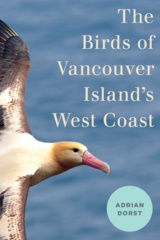
Nunavut is a land of islands, encompassing some of the most remote places on Earth. It is also home to some of the world’s most fascinating bird species. The windswept tundra, rocky shorelines, and icy waters of this thinly populated land are integral to the survival of numerous breeding and non-breeding birds, including the colourful King Eider, the stately Snowy Owl, the spritely Snow Bunting, and the globe-spanning Northern Wheatear.
Birds of Nunavut is the first complete survey of every species known to occur in the territory. Co-written by a team of eighteen experts who have conducted a combined total of 300 seasons of fieldwork in Nunavut, they document 295 species of birds (of which 145 are known to breed there), presenting a wealth of information on identification, distribution, ecology, behaviour, and conservation. Lavishly illustrated with over 800 colour photographs (showing plumages, nests, eggs, and young for most breeding species) and 145 range maps, it is a visually stunning reference work on the birds that live in and visit Nunavut.
Volume 1 of this two-volume set contains species accounts for the nonpasserine birds of Nunavut (from Ducks, Geese, and Swans to Falcons). It also provides an overview of Nunavut’s geography and ecology, bird conservation concerns, and the history of the study of birds in the territory. Volume 2 provides species accounts for the passerine birds of Nunavut (from Tyrant Flycatchers to Cardinals). It also contains four appendices (including a species checklist) and the references and index for both volumes.
This book is a must-have for bird enthusiasts of all sorts, including birders (both serious and armchair), ornithologists, researchers, naturalists, resource managers, and tourists.
This two-volume set offers a state-of-the-knowledge survey of the birds of Nunavut, particularly of those species that breed there. Chapters on the geography, history, ecology, and environments of Nunavut provide comprehensive context for the bird descriptions. The Arctic is changing rapidly and this beautifully illustrated book will be the standard reference against which all new knowledge will be measured.
Birds of Nunavut will open the eyes of people who may never enjoy the Arctic in person. People everywhere should care about the Arctic and efforts made to protect its rich diversity. I especially enjoy the emphasis on birds in this book not only because I am a life-long birder but also because birds are literally the canaries in the coal mine. Preserving their habitat relates directly to preserving ourselves.
Birds of Nunavut provides a much-needed assessment of the status of birds in this vast region. At this crucial juncture of our history, when we have started to realize the disproportionate impacts of climate change on the northernmost parts of the planet, understanding the makeup of its avifauna is ever more important and will help us understand better how it is changing, and perhaps, hopefully, help preserve it.
Birds of Nunavut provides a comprehensive baseline of avian occurrences, phenology, and population trends. It affords a solid framework for accelerating research and new knowledge as ongoing climate modification, industrial activity, and national sovereignty issues intensify.
Birds of Nunavut is an essential addition to the library of all those seriously interested in the Arctic. Much more than a field guide, it contains highly readable accounts of the history, geography, and ecology of the region, as well as comprehensive field accounts of all species. The book is beautifully illustrated throughout with stunning photographs and maps.
In the coming years, climate change is expected to affect the Arctic in many ways. We are already seeing its impact on birds, including changing prey species for Southern Arctic seabirds; ‘shrubification’ of former tundra that affects nesting waterfowl and sea ducks; and increasing storm events that put migrating shorebirds at risk. Birds of Nunavut provides a comprehensive snapshot of the current knowledge about Nunavut’s birds by which to calibrate future change.
James M. Richards is a self-taught naturalist and award-winning wildlife photographer. He has travelled extensively throughout Canada, the US, Central and South America, and East Africa to study birds and other wildlife. He spent 14 summers in Nunavut and 8 summers in Churchill, Manitoba, observing birds. He has received numerous awards for his work on birds, conservation, and the environment, including an Environmental Citizenship Award, a Queen’s Golden Jubilee Medal, the Ontario Medal for Good Citizenship, and a Distinguished Ornithologist award from the Ontario Field Ornithologists.
Anthony J. Gaston is a naturalist, ornithologist, and ecologist who, as a senior research scientist with Environment Canada, has studied Nunavut birds since 1975. He specializes in the study of marine birds in the Arctic and Haida Gwaii, particularly the impact of climate change on them. He has received a Lifetime Achievement Award from the Pacific Seabird Group, the Doris Huestis Speirs Award for Outstanding Contributions to Canadian Ornithology, and the Jamie Smith Mentoring Award from the Society of Canadian Ornithologists.
Birds of Nunavut is written by a team of academics, government researchers, and independent environmental consultants who have not only carried out extensive ornithological studies in Nunavut but are also avid birders: Kenneth F. Abraham, Geoffrey Carpentier, Alastair Franke, Anthony J. Gaston, Gilles Gauthier, Victoria H. Johnston, Richard W. Knapton, Myles M. Lamont, James O. Leafloor, Mark L. Mallory, Robert D. Montgomerie, Mark K. Peck, Jennie Rausch, James M. Richards, Gregory J. Robertson, Paul A. Smith, Jean-François Therrien, and Y. Robert Tymstra.
Foreword by Jason Akearok
Preface
Guide to the Species Accounts
Introduction
Geography and Ecology of Nunavut
Important and Protected Areas for Birds
The History of Ornithology in Nunavut
Avian Monitoring in Nunavut: Past, Present, and Future
Climate Change and Other Threats to Arctic Birds
Species Accounts: Nonpasserines
Species Accounts: Passerines
Appendices
References
Index











